In a recent blog I stated that “Crossing the AI Chasm” is primarily an organizational and cultural challenge, not a technology challenge. That “Crossing the AI Chasm” not only requires organizational buy-in, but more importantly, necessitates creating a culture of adoption and continuous learning fueled at the front-lines of customer and/or operational engagement (see Figure 1).
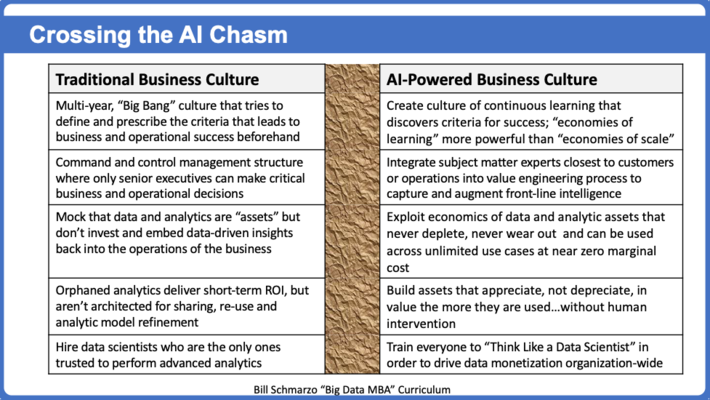
Figure 1: Crossing the AI Chasm
A recent Harvard Business Review (HBR) article “Building the AI-Powered Organization” agrees that despite the promise of AI, many organizations’ efforts with it are falling short because of a failure by senior management to rewire the organization from the bottom up. This includes:
- Transitioning from siloed work to interdisciplinary collaboration.
- Moving from experience-based, leader-driven decision making to data-driven decision making at the front-line.
- Transforming the organization from rigid and risk-averse to agile, experimental, and adaptable.
The above points – interdisciplinary collaboration, data-driven at the front-line, and experimental and adaptive – are the hallmarks of an organization where everyone has been trained to Think Like a Data Scientist.” So, how can your organization embrace the liberating and innovative process of getting everyone to “Think Like a Data Scientist”?
Let’s begin by first establishing what we mean by “Building an AI-Powered Organization.”
What Does Building an AI-powered Organization Mean?
The HBR article doesn’t define the criteria for what comprises an AI-Powered Organization; that is, how to measure an organization’s AI Maturity. So, let me give you my criteria for how an organization leverages AI (including various forms of Machine Learning, Deep Learning and Reinforcement Learning) to build an AI-Powered Organization.
An AI-Powered Organization leverages AI to:
- Couple market, economic, society and competitive data with the organization’s operational data to uncover and codify customer, product and operational insights that support short-term (Horizon 1) and long-term (Horizon 2 and 3) business decisions.
- Provide real-time, augmented intelligence to the front-line employees and subject matter experts who are closest to the customers and/or operations of the business.
- Create a differentiated, hyper-personal customer experience that is guided by the intelligence gleaned from every customer transaction and interaction.
- Build products or assets that appreciate, not depreciate, in value through usage; assets that learn and appreciate in valuable with the usage of that product or asset.
- Master the discipline of identifying, packaging, sharing and refining the analytics that derive and drive new sources of customer, product and operational value.
- Incorporate holistic society and environmental variables and conditions into the creation of the AI Unity Function that guides the learning and execution of your AI models.
- Institutionalize a methodology for determining the economic value of their data. Since data is the fuel for AI, a disciplined approach for valuing data is essential to optimize data acquisition, quality, governance and enrichment investments.
Let’s see how the “Thinking Like a Data Scientist” methodology supports the building of an AI-powered organization.
TLADS Key #1: Leverage Interdisciplinary Collaboration
“The AI-Powered Organization” understands that conflict, diversity and collaboration are key to driving innovation and identifying those variables and metrics that might be better predictors of performance. For example, if you had challenged car manufacturers in 1979 to increase the horsepower AND mileage per car, the automobile executives would have looked at you as if you had lobsters crawling out of your ears. However, that is exactly what happened! The conflict between “Fast AND Efficient” fueled new automobile innovation.
The more dimensions against which you have to optimize, the more creative and innovative your data and analytic-driven solutions are going to have to be, and the bigger the impact on your organization’s economic value curve. For example, increasing operational uptime while reducing maintenance costs while improving customer satisfaction while reducing carbon footprint and emissions while increasing employee job satisfaction (see Figure 2).
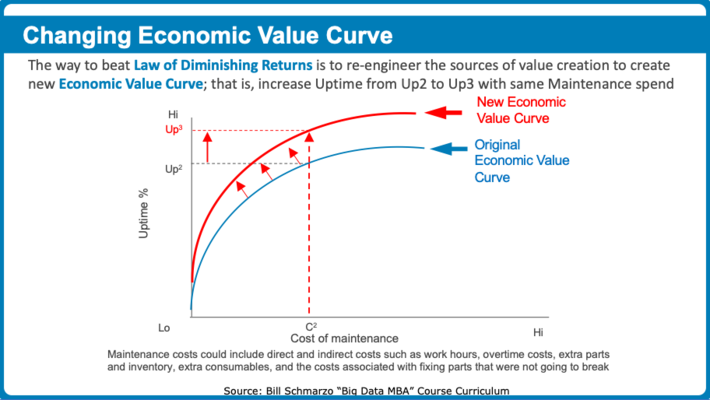
Figure 2: Transforming Your Economic Value Curve
TLADS Key #2: Empower Front-line, Operational Intelligence
To transform the organization from experience-based, senior management-driven making to data-driven decision making at the front-lines requires the blending of Design Thinking with Data Science in order to uncover and codify the latent business and operational knowledge buried in the heads of the front-line subject matter experts. Everyone who is learning how to Think Like A Data Scientist” will also be trained in some Design Thinking basics so that they are better prepared to identify, validate, value and prioritize customers’ sources of gains and pains (see Figure 3).
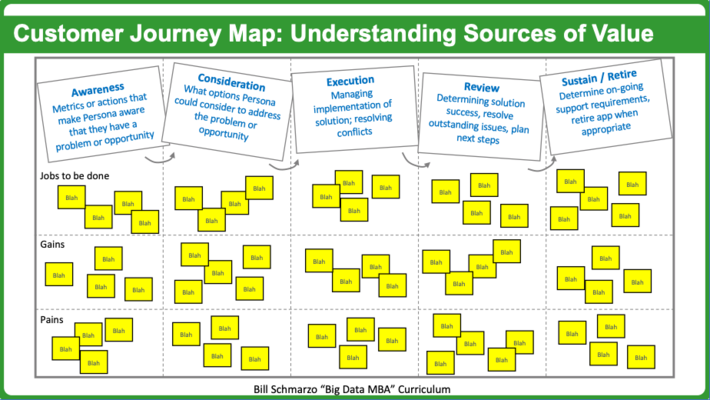
Figure 3: Design Thinking and Customer Journey Maps
Design Thinking and Data Science are natural partners because…
Data Science uncovers patterns, trends and relationships buried in data. Design Thinking uncovers patterns, trends and relationships buried in SME’s.
Design Thinking unleashes the critical juices of the subject matter experts – the front-lines of customer and operational engagement. For example, as the organization’s Subject Matter Experts retire, there is an opportunity to leverage Design Thinking plus a “Thinking Like a Data Science” mentality to identify, validate, codify and scale the heuristics used to keep operations running smoothly; the opportunity to turn every technician, engineer, physician, and teacher into your best technician, engineer, physician, and teacher (see Figure 4).
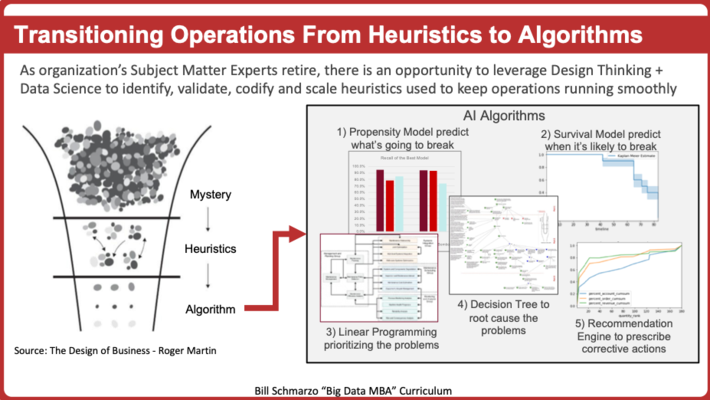
Figure 4: “Exploit Economics of Autonomous to Transform Your Organization”
TLADS Key #3: Embrace Experimentation and Learning
To transform the organization from rigid and risk-averse to agile, experimental, and adaptable requires an entirely new way of thinking about where and how operational decisions need to be made. And the “Whiteboards versus Maps” analogy portrays the innovation challenge nicely.
Most organization’s business strategies can be best portrayed as a map – a highly-engineered document that carefully predefines each move (play) the organization needs to make to be successful. Whiteboards, on the other hand, represent a “way of thinking” – where ideas can be quickly captured, explored, refined, morphed and possibly discarded – by cross-functional teams collaborating and brainstorming to understand and monetize market patterns and relationships, flesh out responsibilities, draft plans and create a dynamic business strategy that can be constantly tweaked based upon changing market dynamics (see Figure 5).
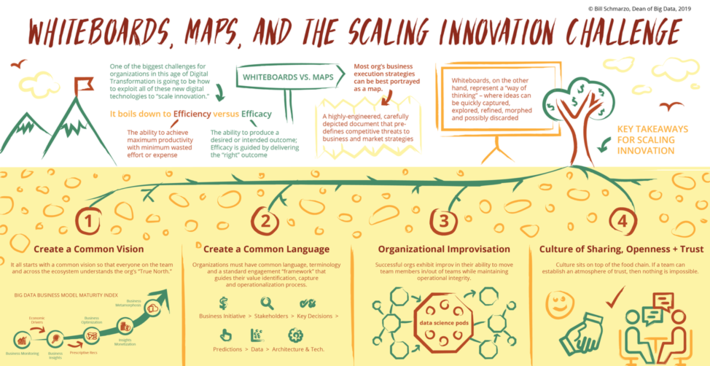
Figure 5: Scaling Innovation: Whiteboards versus Maps
A key part of creating a learning organization is mastering the art of Unlearning. It takes years – sometimes a lifetime – to perfect certain skills. Malcolm Gladwell’s book “Outliers” postulates that it takes 10,000 hours of practice to perfect a skill. But once we get comfortable with something that we have mastered, we become reluctant to change. We are reluctant to unlearn what we’ve taken so long to master. And that sort of resistance will be the death of the AI-Powered Organization.
TLADS Key #4: Become Value Engineering Driven
Value Engineering is a business engagement methodology that focuses on leveraging data and analytics to derive and drive new sources of customer, product and operational value. The Value Engineering Framework starts with the identification of a key business initiative that not only determines the sources of value, but also provides the framework for a laser-focus on delivering business value and relevance.
The heart of the Data Science Value Engineering Framework is the collaboration with the different stakeholders or subject matter experts to identify, validate, value and prioritize the key decisions (use cases) that they need to make in support of the targeted business initiative.
After gaining a thorough understanding of the top priority decisions (use cases) the analytics, data, architecture and technology conversations now have a frame within which to work (by understanding what’s important AND what’s not important). See Figure 6.
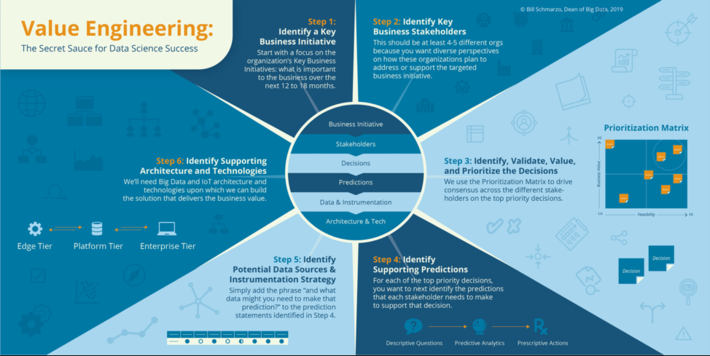
Figure 6: “Value Engineering: The Secret Sauce for Data Science Success”
Summary: Building the AI-Powered Organization
The innovative thinking necessary to build an AI-Powered Organization can be unleashed by training everyone to “Think Like A Data Scientist”; to constantly challenge conventional business and operational thinking to re-engineer the organization’s value creation processes.
The AI-Powered Organization leverages the “Thinking Like A Data Scientist” methodology to:
- Leverage Interdisciplinary Collaboration
- Empower Front-line, Operational Intelligence
- Embrace Experimentation and Learning
- Become Value Engineering Driven
So, what is your organization willing to invest in your employees – the secret sauce for building the AI-powered organization – to teach them how to “Think Like a Data Scientist”?
